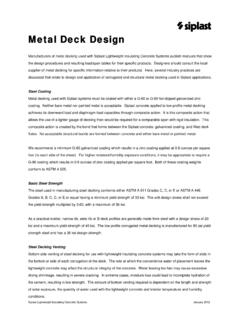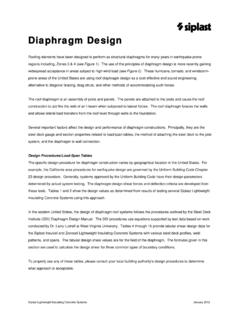Transcription of Vertical Load Data - Siplast
1 Vertical load Data Roof insulation assemblies must be able to resist Vertical live and dead loads imposed by snow, ponded water, roofing gravel or ballast, and other local conditions. Generally, Vertical loads are resisted solely by the structural concrete deck or other structural system. Siplast lightweight insulating concrete Systems are placed over corrugated steel decking, structural steel decking, and structural concrete . Where appropriate, they are used in reroofing applications over existing roofing. In the case of structural concrete , the concrete is generally strong enough to resist the dead plus live loads without structural contribution from the Siplast lightweight insulating concrete System. Reroofing applications require the structural consideration of the existing roof system in conjunction with the dead load imposed by the addition of a Siplast lightweight insulating concrete System.
2 Steel decking, depending on steel gauge and span, may require a structural contribution by the Siplast lightweight insulating concrete System to provide acceptable resistance to deflection from live loads. The following information reviews the considerations necessary when using a Siplast lightweight insulating concrete System over different substrates. Steel Decking (New Construction) Historically, the greatest number of ZIC applications have been placed over galvanized steel decking. Of the total steel deck applications, the greatest number have been over light gauge galvanized corrugated steel form material. Corrugated steel is usually used in 916-inch depths with a 28-gauge thickness and in 1516- or 1516- inch depths with a 26-gauge thickness or heavier. Today's corrugated steel decking is rolled from steel having a minimum yield strength of 80 ksi as opposed to standard steel decking which is generally made from 33 ksi to 40 ksi minimum yield strength steel.
3 The higher minimum yield strength for corrugated profiles results in an allowable flexural stress limit of 36 ksi compared to standard steel decking which uses 20 ksi as the allowable flexural stress limit. The higher allowable design flexural stress limit for corrugated steel generally results in comparable total loads at equal spans for more shallow profiles. Corrugated steel, as opposed to structural steel decking, may not be able to support live loads within acceptable deflection limits by itself. Decades of ZIC applications have shown that the composite action of the ZIC and corrugated deck is more than adequate to provide long term performance with acceptable deflection limits. In order to have composite action, a bond must be created between the insulating concrete and steel. For example, the tensile bond between galvanized steel and ZIC ranges from 5-10 psi, depending on mix design and density.
4 This bond strength results from a chemical reaction between the products of cement hydration and zinc coating on the steel. Siplast lightweight insulating concrete Systems January 2012 The resulting strength will, therefore, range from 720 to 1440 pounds per square foot of uplift resistance. This same bond causes composite action to occur in Vertical load applications. For example, a 1516-inch profile corrugated steel of 26-gauge thickness and spanning 6 feet would have a design load capability based on stress of 61 psf and a deflection limit load at L/240 of 21 psf. However, when this same steel is tested with a ZIC/Insulperm System, the composite ultimate load is 256 psf and L/240 deflection load is 110 psf. This is a significant improvement over a design of only steel. Several Siplast systems have been tested with various steel decking and spans.
5 The data is shown in the Downward Loading Properties for Corrugated Metals Designs. You will note that values for composite Vertical loads in these data sheets are significantly above corresponding loads for steel only from steel deck catalogs. Not all building code jurisdictions allow design based on composite action of Siplast concrete . Check with your local building department before designing based on composite action. Whether the code authority allows composite design or not, the Siplast lightweight insulating concrete System composite action results in increased safety factors compared to steel only criteria. One check is required of the steel decking itself. At time of placement, a typical ZIC 1:6 concrete mix would weigh approximately lb/board foot. The total placement load of lb/bf multiplied by the concrete thickness in inches must not exceed the L/240 deflection loading for the steel only.
6 Should this placement load exceed the deflection loading for the steel only, the steel will deflect, resulting in excessive amounts of concrete being used. This will cause additional loading to the structural supports. To determine the appropriate load carrying capability of steel decking at various spans, please refer to catalogs of specific steel deck manufacturers for their load /span tables. Table 3, a load /span table for several commonly used sizes of Wheeling Corrugating Company's Tensilform/Tensilvent is included in this section. Structural concrete Structural concrete has more Vertical loading capability than steel decking, so the weights of Siplast lightweight insulating concrete Systems are of reduced concern. However, long term loading should be kept to its lowest in order to reduce creep deflection of the structural concrete .
7 Our general recommendation is to use NVS lightweight insulating concrete in place of ZIC in these applications. The major advantage of using NVS is its ability to be placed at a minimum 1-inch thickness as opposed to the 2-inch minimum for ZIC. The use of NVS and stairstepped Insulperm to provide slope-to-drain will result in the lowest weight application with highest insulation value. Siplast lightweight insulating concrete Systems January 2012 Reroof Substrate Each reroofing situation is unique and should be carefully evaluated. If the existing roof insulation is suitable for reuse, it may be possible to place a Siplast lightweight insulating concrete System over it provided a structural overload does not occur. NVS lightweight insulating concrete and Insulcel lightweight insulating concrete are acceptable Siplast lightweight insulating concrete Systems for use in reroofing applications.
8 Considerations must be given to existing allowable design weights, weight of materials to be removed, and weight added by the new roofing assembly in reroofing applications. A structural engineer should assess whether the structure is capable of supporting the weight of the new roof assembly. Siplast lightweight insulating concrete System Weights The tables appearing at the end of this section show the design weights for ZIC, NVS, Insulcel, and Zonocel Siplast lightweight insulating concrete Systems with various Insulperm thicknesses. Always use weight values based on the wet density of the material to calculate the loading impact of Siplast lightweight insulating concrete Systems on the structure. If Insulperm insulation board is encapsulated in the lightweight fill assembly in a stair-stepped fashion, an additional 1/2-inch thickness of fill material should be added to the wet weight calculations to take into account the stair-stepped nature of the Insulperm board and amount of top fill placed over it.
9 Siplast lightweight insulating concrete Systems January 2012 Table 1 Siplast lightweight insulating concrete System Weights 2" of ZIC 1:6 Mix Design Over Metal Decking 26 ga. Metal 24 ga. Metal 22 ga. B-Deck 22 ga. Metal 15/16" Corrugation1-5/16" Corrugation1-1/2" Profile Type N 3 Profile Thickness Weight Weight Weight Weight of of Metal, of Metal, of Metal, of Metal, Insulperm Insulperm, Insulperm, Insulperm, Insulperm, & ZIC & ZIC & ZIC & ZIC (Inches) (PSF)* (PSF)* (PSF)* (PSF)* 0" 1" 1-1/2" 2" 2-1/2" 3"
10 3-1/2" 4" 5" 6" 7" 8" 9" 10" 11" 12" * insulating concrete weight based on 22 pcf dry density.









